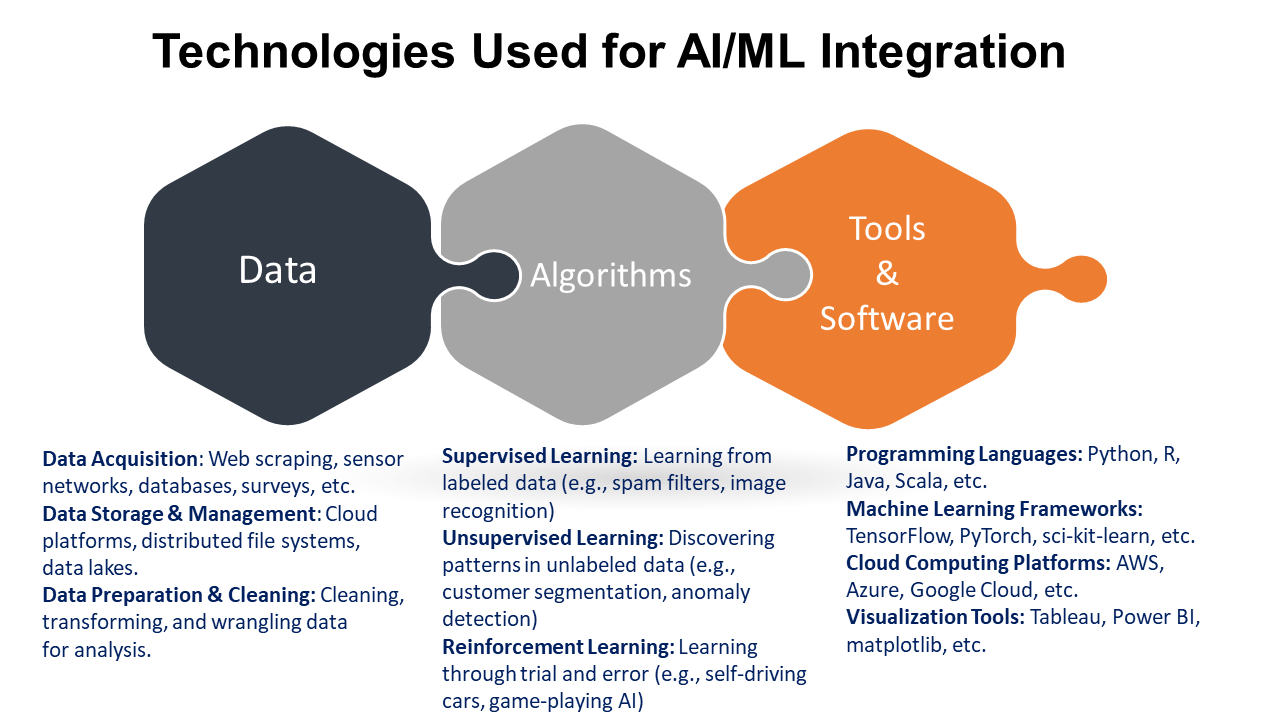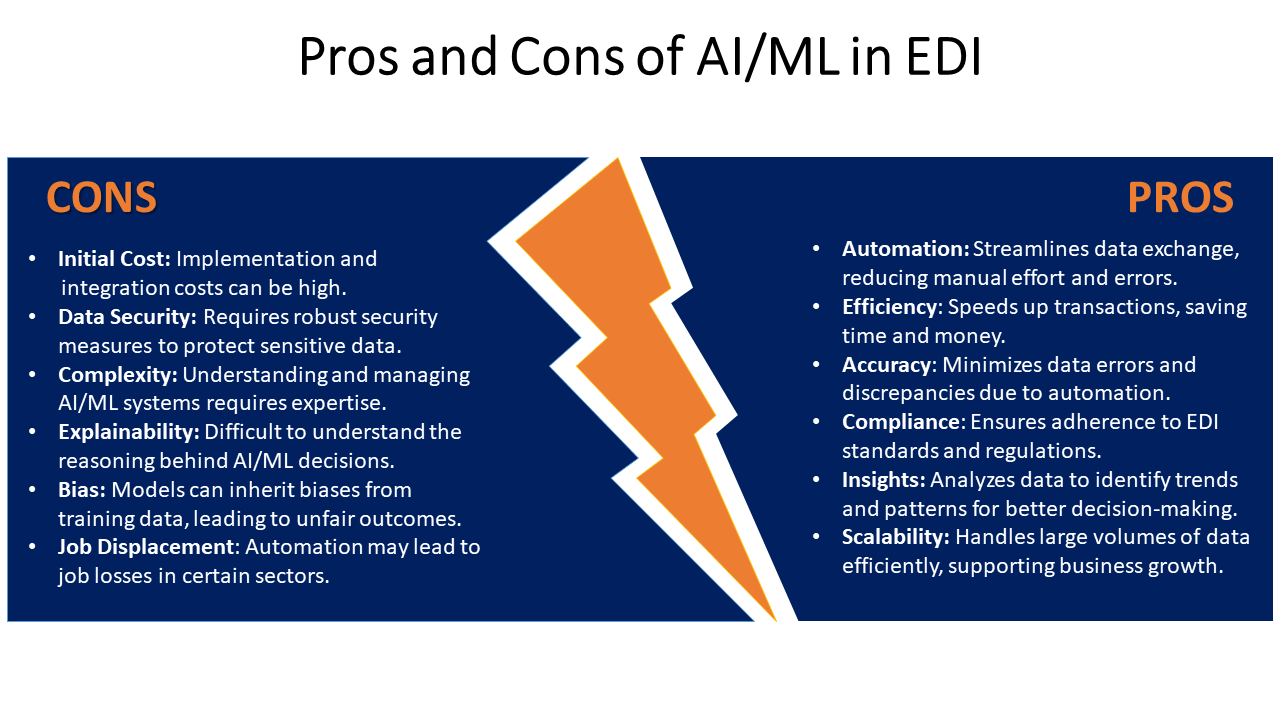Table of Contents
Electronic data exchange is helping business organization in significant manner by increasing efficient and productivity of their day-to-day operations. It has affected the manner in which business organization are exchanging data between each other with the help of technology. This blog discusses the role of AI & ML in improving compliance, overcoming integration challenges, and pushing the boundaries of what’s possible with EDI solutions.
What is Electronic Data Interchange (EDI)?
Electronic data interchange (EDI) permits groups to ship and acquire standard enterprise records electronically rather than the use of traditional paper documents. Companies use EDI to streamline the ordering process and cut costs associated with paper documents. Between agencies and their EDI providers, customers, and partners, EDI facilitates automated, paperless transactions. These speeds up processes like ordering, invoicing, and payment between companies. The EDI market is projected to grow from USD 1.88 billion in 2024 to USD 4.04 billion by 2029, exhibiting a CAGR of 11.6% during the forecast period.
How does EDI work?
For Electronic data interchange to work, companies need to agree on data standards to structure and define the EDI messages and documents they exchange. They also must have software to translate data from their internal systems into the agreed EDI format and vice versa.
An agency creates EDI documents from its inner machine and sends these digital documents to a buying and selling associate’s EDI system. The receiver’s EDI machine then translates the incoming EDI documents into its internal layout so it is able to method the records.
Need for Electronic Data Interchange
Companies benefit from EDI solutions by means of reducing expenses for paper documents, document coping with, statistics entry, and exception coping with paper documents. They also gain faster order processing, order confirmation, and invoice reconciliation when documents are transmitted electronically instead of through mail.
EDI is pretty popular in the supply chain industry, with somewhere between 59 and 85% of companies adopting the technology.
However, deploying EDI necessitates spending money on technology like EDI software, educating staff members on how to use the new tool, and working with partners in buying and selling to establish EDI report standards. Ongoing communication is also needed to resolve any EDI issues or changes.
It can be said that one of the primary advantages of EDI is its ability to automate business operations that require a significant amount of time and human effort from the organizations. Compared to using paper documents for ordering, invoicing, and billing between businesses, EDI enables faster processing, lower costs, and fewer mistakes.
Importance of Integrating AI & ML in EDI Systems
Electronic data interchange (EDI) systems allow agencies to electronically change facts like orders and invoices. However, EDI data can be error-prone and messy due to various issues at different stages. Integrating artificial intelligence (AI) and machine learning can assist overcome these challenges and enhance the efficiency of EDI structures.
AI & ML tools can be used to validate EDI documents before they are transmitted. They can check for simple errors like missing fields, incorrect formatting, and data type mismatches. This reduces the chances of data transmission failures and rejections.
ML algorithms can be trained to recognize mistakes and inconsistencies in EDI data from past transactions. They can detect errors like invalid product codes, incorrect addresses, quantity mismatches, and pricing discrepancies. This helps catch errors earlier before they impact order fulfillment.
Integrating AI into EDI solutions mapping processes can also simplify mapping complex EDI documents. ML algorithms can be trained to recommend the most accurate field mappings between a company’s data and standard EDI formats.
According to IBM, “Companies need to support both a core set of EDI transaction types and API capabilities or risk missing out on important opportunities to drive revenue, growth, and competitive differentiation.”
Integrating AI & ML can enhance EDI systems in many ways. They can validate data, detect errors, interpret unstructured notes, analyze patterns, flag anomalies, and simplify EDI mapping. This helps improve data quality, reduce rejections, speed up order fulfillment, and strengthen trading partner relationships through more accurate and reliable EDI information exchange.
Improve Your EDI Processes With AI & ML Integration
Evolution of EDI and the Need for Advancements
- EDI was first used by business organizations during the 1970’s.
-Primarily businesses were using this technology to create better communication between different departments that were exchanging documents.
-Initially, EDI used proprietary formats and value-added network EDI providers to transmit data.
- In the 1980s
Standards for EDI documents and communication protocols emerged. These allowed businesses using different EDI software to exchange data. However, EDI was mainly used for basic transactions like orders and invoices.
- In the 1990s and 2000s
EDI started being used to exchange more complex documents like shipping notices, advanced shipping notices, bills of lading, and customs data. More businesses adopted EDI to automate transactions with clients and EDI providers.
While EDI services provided many benefits compared to paper documents, they still had several limitations. EDI standards have changed little over the years and still rely on rigid document formats. Errors and exceptions require manual intervention. Data mapping between internal systems and EDI remains complex.
Key advancements that are needed for the next generation of EDI include:
- Adoption of XML and JSON formats instead of proprietary EDI standards
- Real-time visibility and tracking of EDI-managed services documents and transactions
- Integration of AI & ML for data validation, exception handling, and mapping
- Event-driven architecture that can support event-based notifications and alerts
- Cloud-based EDI platforms for better scalability and collaboration
- Mobile and API-based access for EDI document management
While EDI has enabled significant automation of business transactions, the current limitations show that there is scope for more innovation. Adopting newer technologies, standards, and architectures can transform EDI into a faster, more flexible, intelligent, and real-time platform for business-to-business communication. This will help businesses gain even greater efficiency and competitiveness through more streamlined supply chains and operations.
What is Artificial Intelligence (AI) and Machine Learning (ML)?
Artificial intelligence (AI) can be defined as the technology that helps business organizations perform certain tasks that are generally associated with intelligent beings such as humans. Machine Learning (ML) is a utility of AI that offers structures the capacity to mechanically examine information and enhance enjoyment.
Machine learning algorithms assemble a mathematical version primarily based on pattern statistics, referred to as schooling, so you can make predictions or choices without being explicitly programmed to perform the task. ML algorithms change when exposed to new data.
Some examples of simple machine learning are spam filters in emails that learn to detect spam messages automatically, product recommendation systems that learn users’ preferences to suggest relevant items, and digital assistants that improve over time by learning from user interactions.
While machine learning is a part of synthetic intelligence, now not all artificial intelligence calls for machine learning. For example, expert systems use specific rules to mimic human intelligence but do not learn from experience.
In short, artificial intelligence is the broad concept of machines mimicking human intelligence while machine learning is an application of AI that enables systems to automatically learn from data and improve from experience. With machine learning, systems are fed data and certain patterns are identified, enabling the systems to make accurate predictions even with data it has not been exposed to before.

Automated Data Mapping and Translation
Data mapping and translation is an essential but often complex and time-consuming part of implementing Electronic Data Interchange (EDI) between businesses. Artificial intelligence (AI) and machine learning (ML) technology can now automate large parts of the EDI data mapping process. This brings several benefits like faster implementation, improved accuracy, and lower costs.
Traditionally, EDI records mapping calls for technical specialists to manually define the connection between every record subject in an EDI document and the corresponding area in a corporation’s internal device. This process can be error-prone and requires testing to ensure accuracy.
AI & ML powered mapping
With AI & ML technology, algorithms can be trained to analyze EDI format specifications, existing EDI mappings, and sample data. The algorithms can then recommend the optimal mapping of EDI fields to a company’s internal data structure. By using AI & ML for “intelligent automation”, businesses can drastically reduce the manual effort required for EDI solutions mapping.
ML algorithms can also improve over time as they gain exposure to more data and examples of correct EDI mappings. As new EDI formats and standards emerge, AI-assisted mapping can adapt quickly by training the ML models on the new specifications. This makes the mapping process more agile and responsive to change.
By automating the initial creation of EDI data mappings, AI and ML technology can significantly speed up the time taken to onboard new trading partners. This helps businesses expand their EDI networks faster.
The accuracy of automatically generated EDI mappings can also be higher since algorithms are less prone to human errors. Machine-assisted mappings can then be reviewed and refined by experts to ensure correctness before implementation.
AI & ML technology is revolutionizing the traditionally manual process of EDI data mapping. Automated mapping can accelerate trading partner onboarding, reduce costs, improve accuracy, and enable more agile adaptation to evolving EDI formats. AI & ML have the potential to transform data mapping and translation – a foundational step for effective Electronic Data Interchange between businesses.
Upgrade Your Data Exchange Game with Our Proven EDI Services!
Enhanced Data Validation and Error Handling
One of the biggest challenges with Electronic Data Interchange (EDI) is making sure the accuracy and reliability of exchanged information. Errors and exceptions in EDI documents can cause delays, wasted effort and poor customer experience. AI & ML technology can now automate and improve data validation processes as well as the handling of EDI exceptions. This enhances the overall effectiveness of EDI systems.
Using ML algorithms, EDI services data can be automatically validated at the time of transmission for things like missing or invalid fields, incompatible data types, inconsistencies between items, and failure to meet business rules. The algorithms are trained on known EDI errors and exceptions to recognize patterns that indicate potential issues. Invalid transactions can then be flagged and rejected before being processed.
AI assistants powered by natural language processing (NLP) can analyze the free-form notes in EDI managed services documents to extract additional information that may signal errors. This context helps uncover issues that simple data checks may miss. The AI assistants can also make recommendations to resolve errors more quickly.
Role of ML Techniques
ML techniques like anomaly detection and time series analysis can monitor EDI transactions over time to flag unusual changes and abnormalities. This enables businesses to proactively investigate potential issues with trading partners before they affect order fulfillment. Machine learning models trained on historical EDI data can accurately differentiate valid changes from anomalies.
For EDI exceptions that do arise, the AI & ML era can automate responsibilities like notifying the applicable parties, assigning obligations to resolve issues, and monitoring exceptions to closure. AI-based orchestration of exception-handling processes reduces manual effort and speeds up resolution.
Real-time Data Tracking and Monitoring
Currently, EDI data is exchanged in batches, often on a daily or weekly basis. There is little to no real-time tracking of individual EDI service documents as they move through the system. As a result, any errors or exceptions may not be detected until after the scheduled data exchange, leading to delays.
Using AI and ML, EDI documents can be continuously monitored from the point of transmission. ML algorithms can analyze transmitted data in real-time to detect issues, flag exceptions, and trigger alerts. Any changes in EDI document status – from transmitted to received to processed – can automatically notify the relevant parties.
Monitoring
With real-time EDI solutions data tracking, businesses gain visibility into critical events as they happen. They can respond to issues more quickly and proactively resolve potential problems while impacts are still minimal. This reduces costs from errors, waste, delays, and lost productivity.
AI assistants powered by NLP and ML models can orchestrate real-time exception handling workflows. As soon exceptions are detected, AI assistants can assign tasks to the appropriate teams and individuals, provide context on the nature of the issue, and track tasks until resolution. This accelerates the end-to-end exception resolution process.
Real-time EDI data tracking also enables event-driven processes that trigger actions based on critical events. For example, ML models can predict shipping delays based on historical EDI shipment data and proactively notify suppliers to avoid stockouts.
Improved Supply Chain Management
Real-time EDI data tracking powered by machine learning gives businesses up-to-the-minute visibility into order statuses, shipment details, delays, and other events. They can monitor the supply chain as it happens and intervene instantly when needed.
AI-based predictive analytics can also help optimize the supply chain. By reading historical EDI records, system learning models can are expecting calls for tendencies, order patterns, transit instances, and more. Businesses can then plan production, inventory, and logistics more efficiently.
AI-assisted decision-making using optimization techniques can recommend supply chain configurations that minimize costs while meeting service-level targets. Optimization of parameters like inventory levels, transportation modes, production schedules, and supplier allocation is done for maximum efficiency.
AI-Powered Fraud Detection and Security
AI-based anomaly detection techniques can monitor EDI transactions continuously to identify suspicious patterns indicating potential fraud. Machine learning algorithms are trained on examples of known EDI fraud and legitimate activities to differentiate between the two. Any unusual transactions, changes, or abnormalities are then flagged as potential threats.
Natural language processing (NLP) techniques can analyze the content of free-form notes within EDI documents to detect fraudulent language or indicators of compromised accounts. Combined with anomaly detection, NLP improves the accuracy of AI-based fraud screening.
Machine learning models can also be trained to recognize the signatures of different types of EDI solution threats like data tampering, phishing attacks, fake invoices, and unauthorized access. As new threats emerge, the ML models can adapt by incorporating examples of the latest fraud schemes. This keeps fraud detection up-to-date and effective over time.
Real-time EDI data streaming and event processing powered by AI enables instant fraud detection as suspicious activities occur. Transaction confirmation messages can immediately notify trading partners of potentially fraudulent documents, limiting impacts.
AI assistants can also automate fraud response procedures like account lockdowns, password resets, document recalls, and workflow approvals. This orchestration of fraud response reduces the time taken to mitigate threats and recover from incidents.
Security
AI and ML technology can significantly strengthen the security of EDI systems by continuously analyzing data and documents for fraud indicators, detecting threats in real-time, adapting to new schemes, instantly notifying stakeholders, and automating fraud response processes. This reduces EDI systems’ vulnerability to fraud while improving overall supply chain integrity and trading partner trust.

Addressing EDI Integration Challenges
Artificial Intelligence and Machine Learning technology offer capabilities to triumph over EDI integration hurdles. Some key challenges and how AI/ML can address them:
- Data formatting – EDI software solutions information comes in many extraordinary formats from diverse buying and selling companion structures that can examine records from more than one asset, study their systems and syntax, and convert them right into a general layout for integration.
- Error managing – EDI transactions frequently include errors due to inconsistencies in records fields. AI structures can become aware of commonplace error sorts, flag ability troubles, and robotically correct errors or course them for manual review.
- Interoperability – Different EDI structures use protocols and requirements, that affect their capability to connect and talk. AI-powered middleware can translate facts among a couple of protocols to permit interoperability.
- Change management – Frequent changes in EDI requirements and trading partner requirements are difficult to put into effect manually. AI tools can perceive modifications, routinely reconfigure interface mappings, and replace systems with minimal human intervention.
- Monitoring– It is hard for humans to continuously track EDI software solutions data exchange for issues. AI monitoring tools can detect anomalies, latency, and other problems in real time, helping resolve integration issues quickly.
- Traceability – It can be difficult to trace the origin of EDI documents as they pass through multiple systems. Technologies like blockchain can provide an immutable audit trail for end-to-end visibility and traceability.
Synchronize Your Data Seamlessly with Our Expert EDI!
Future Trends and Possibilities
Electronic Data Interchange allows businesses to exchange structured information electronically for activities like order placement, payments, and inventory management. Artificial Intelligence and Machine Learning technologies are making complete EDI solutions smarter, faster, and more reliable. Here are some future trends and possibilities in this space:
Real-time data exchange –
ML algorithms will enable near real-time EDI data exchange between businesses for time-sensitive transactions. This requires high throughput, and low latency integration technologies.
Proactive issue resolution –
AI systems will proactively detect and resolve EDI issues like transaction failures, errors, and latency. They will fix problems with minimal human input using self-healing capabilities.
Instant document processing –
AI technologies like computer vision and natural language processing solutions will enable the instant processing of EDI documents through optical character recognition and text analysis. This will improve efficiency and reduce delays.
Smart recommendations –
ML systems will provide actionable recommendations to optimize EDI networks. They will suggest process improvements, configuration changes, partnership strategies and more based on data insights.
Personalized EDI tools –
AI technologies will develop profiles of individual users and create personalized EDI systems tailored to their specific needs and workflows. This will enhance usability and productivity.
In the coming years, AI and ML technologies will make important advances that empower EDI networks with high automation, real-time data exchange, proactive issue resolution, intelligent recommendations, and personalized experiences. These technologies open up new possibilities for seamless and efficient business communication that goes beyond the limitations of traditional EDI.
Conclusion
Modern technologies have huge potential to make EDI smarter, faster, and more reliable. They can automate mundane tasks, proactively resolve issues, and provide insights to optimize EDI networks. While humans will continue to oversee compliance and make key business decisions, AI tools can improve visibility, traceability, and outcomes. The future of EDI solutions looks promising with possibilities like molecular communication, real-time data exchange, and personalized tools powered by AI and ML. However, challenges around data requirements, bias, interpretability, and autonomy still exist.
Frequently Asked Questions (FAQs)






